
Atriplex is a plant genus of 250–300 species, known by the common names of saltbush and orache. It belongs to the subfamily Chenopodioideae of the family Amaranthaceae s.l.. The genus is quite variable and widely distributed. It includes many desert and seashore plants and halophytes, as well as plants of moist environments. The generic name originated in Latin and was applied by Pliny the Elder to the edible oraches. The name saltbush derives from the fact that the plants retain salt in their leaves; they are able to grow in areas affected by soil salination.

Acacia coolgardiensis, commonly known as sugar brother or spinifex wattle, is a shrub in the family Fabaceae. Endemic to Western Australia, it is widely distributed in the semi-arid spinifex country from Carnarvon to Kalgoorlie.

Atriplex semibaccata, the Australian saltbush, berry saltbush, or creeping saltbush, is native to Australia, commonly found in coastal regions from South Australia all the way up to Cardwell in Queensland. It is a prostrate growing ground cover plant of the family Amaranthaceae that grows to around 180 cm wide, and flowers year round. It is tolerant of saline and dry conditions making it commonly used as an animal feed source in poorer agricultural areas: it is grazed by livestock, and birds are fond of its fruits. It is also a good species for erosion control.

Calothamnus quadrifidus, commonly known as one-sided bottlebrush, is a plant in the myrtle family, Myrtaceae and is endemic to the south-west of Western Australia. The common name alludes to the arrangement of the flowers in the inflorescence which line up on one side of the stem. It is a shrub with grey-green, pine-like foliage covered with soft hairs and red, four-part flowers in spring. Widely cultivated because of its attractive foliage, colourful, unusual and prolific flowers, it grows in a variety of habitats and soils. In 2010, Alex George published a review of the species based on recent research and described a number of new subspecies.

Atriplex hortensis, known as garden orache, red orache or simply orache, mountain spinach, French spinach, or arrach, is a species of plant in the amaranth family used as a leaf vegetable that was common before spinach and still grown as a warm-weather alternative to that crop. It is Eurasian, native to Asia and Europe, and widely naturalized in Canada, the United States, Australia, and New Zealand.
Atriplex bunburyana, commonly known as Silver Saltbush, is a species of saltbush endemic to Western Australia.
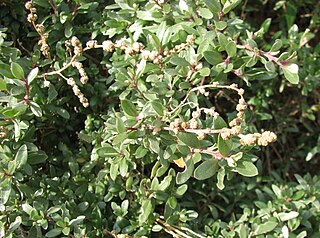
Atriplex paludosa, commonly known as Marsh Saltbush, is a species of saltbush endemic to Australia.
Atriplex paludosa subsp. baudinii is subspecies of Atriplex paludosa that is endemic to Western Australia.
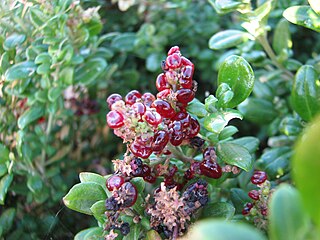
Chenopodium candolleanum, commonly known as seaberry saltbush, is a shrub in the subfamily Chenopodioideae of the family Amaranthaceae, native to Australia.
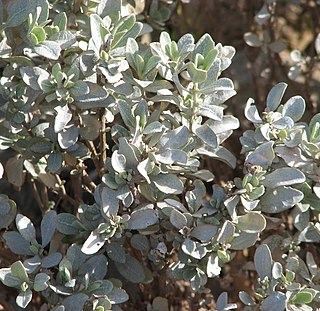
Atriplex vesicaria, commonly known as bladder saltbush, is a species of saltbush endemic to Australia.
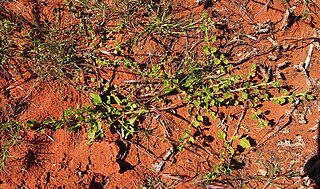
Dysphania melanocarpa, commonly known as Black Crumbweed, is an annual herb that grows in arid and semi-arid regions of Australia.
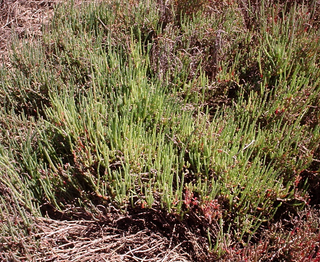
Tecticornia is a genus of succulent, salt tolerant plants largely endemic to Australia. Taxa in the genus are commonly referred to as samphires. In 2007, the genus Halosarcia, along with three other Australian genera was incorporated into the genus.

Chenopodium baccatum, commonly known as berry saltbush, is a species of shrub endemic to Western Australia.
Chenopodium benthamii is a species of shrub endemic to midwest Western Australia.

Tecticornia halocnemoides, commonly known as Shrubby Samphire or Grey Glasswort, is a species of succulent, salt tolerant plant endemic to Australia. It grows as a spreading or erect shrub up to fifty centimetres high. It was first published as Arthrocnemum halocnemoides in 1845, but transferred into Halosarcia in 1980, and into Tecticornia in 2007.

Tecticornia arbuscula, the shrubby glasswort or scrubby samphire, is a species of plant in the family Amaranthaceae, native to Australia. It is a shrub that grows to 2 metres in height, with a spreading habit. It has succulent swollen branchlets with small leaf lobes.

Boronia anemonifolia, commonly known as narrow-leaved boronia or sticky boronia, is a flowering plant that is endemic to south-eastern Australia. It is a shrub with mostly pinnate leaves, with white to pale pink four-petalled flowers in leaf axils.

Boronia crenulata, commonly known as aniseed boronia, is a plant in the citrus family Rutaceae and is endemic to the south-west of Western Australia. It is an open-branched shrub, often trailing between other plants, has strap-like leaves and pink to purple-red, four-petalled flowers in winter and autumn.

Atriplex fissivalvis, commonly known as gibber saltbush, is a plant species in the family Amaranthaceae, subfamily, Chenopodiaceae. It occurs in the Australian states of South Australia, New South Wales, Queensland and the Northern Territory.

Atriplex holocarpa is a low-growing species of Atriplex (saltbush) found throughout arid regions of Australia. A. holocarpa is commonly known as pop saltbush, because its carpals pop when stepped upon.















